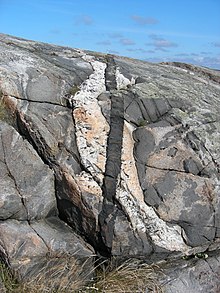Law Of Cross Cutting Relationship

Cross-cutting relationships can exist used to determine the relative ages of rock strata and other geological structures. Explanations: A – folded rock strata cut past a thrust fault; B – large intrusion (cutting through A); C – erosional angular unconformity (cutting off A & B) on which rock strata were deposited; D – volcanic dike (cutting through A, B & C); East – even younger rock strata (overlying C & D); F – normal fault (cut through A, B, C & perchance East).
Cross-cutting relationships is a principle of geology that states that the geologic characteristic which cuts another is the younger of the two features. Information technology is a relative dating technique in geology. It was beginning developed by Danish geological pioneer Nicholas Steno in Dissertationis prodromus (1669) and later formulated by James Hutton in Theory of the Earth (1795) and embellished upon by Charles Lyell in Principles of Geology (1830).
Types [edit]
There are several basic types of cross-cutting relationships:
- Structural relationships may exist faults or fractures cutting through an older stone.
- Intrusional relationships occur when an igneous pluton or dike is intruded into pre-existing rocks.
- Stratigraphic relationships may be an erosional surface (or unconformity) cuts beyond older rock layers, geological structures, or other geological features.
- Sedimentological relationships occur where currents take eroded or scoured older sediment in a local expanse to produce, for case, a aqueduct filled with sand.
- Paleontological relationships occur where the animate being action or plant growth produces truncation. This happens, for instance, when animal burrows penetrate into pre-existing sedimentary deposits.
- Geomorphological relationships may occur where a surficial feature, such as a river, flows through a gap in a ridge of rock. In a similar example, an impact crater excavates into a subsurface layer of rock.
Cross-cut relationships may be compound in nature. For case, if a fault were truncated by an unconformity, and that unconformity cut by a dike. Based upon such chemical compound cross-cut relationships information technology tin exist seen that the error is older than the unconformity which in plough is older than the dike. Using such rationale, the sequence of geological events can be better understood.
Scale [edit]

Cross-cut relationships involving an andesitic dike in Republic of peru that cuts beyond the lower sedimentary strata. Both the dike and the lower strata are cutting by an unconformity

A light-gray igneous intrusion in Sweden cut by a younger white pegmatite dike, which in turn is cut by an fifty-fifty younger blackness diabase dike
Cantankerous-cutting relationships may be seen cartographically, megascopically, and microscopically. In other words, these relationships accept various scales. A cartographic crosscutting relationship might expect like, for instance, a large mistake dissecting the mural on a large map. Megascopic cross-cutting relationships are features like igneous dikes, every bit mentioned above, which would exist seen on an outcrop or in a limited geographic expanse. Microscopic cantankerous-cut relationships are those that crave report by magnification or other shut scrutiny. For example, penetration of a fossil shell past the drilling action of a boring organism is an instance of such a human relationship.
Other utilize [edit]
Cross-cut relationships tin also exist used in conjunction with radiometric age dating to consequence an historic period bracket for geological materials that cannot be directly dated by radiometric techniques. For example, if a layer of sediment containing a fossil of interest is bounded on the superlative and bottom by unconformities, where the lower unconformity truncates dike A and the upper unconformity truncates dike B (which penetrates the layer in question), this method tin can be used. A radiometric age date from crystals in dike A volition give the maximum age date for the layer in question and likewise, crystals from dike B will give u.s. the minimum age date. This provides an age bracket, or range of possible ages, for the layer in question.
Meet also [edit]
![]()
- Principle of faunal succession
- Principle of lateral continuity
- Principle of original horizontality
References [edit]
- Cross Cutting. World of Earth Science. Ed. K. Lee Lerner and Brenda Wilmoth Lerner. Gale Cengage, 2003.
- Nicolai Stenonis solido intra solidum naturaliter contento dissertationis prodromus ... Florentiae : ex typographia sub signo Stellae (1669)
- Hutton, James. Theory of the World, 1795
- Lyell, Charles. Principles of Geology, 1830
Law Of Cross Cutting Relationship,
Source: https://en.wikipedia.org/wiki/Cross-cutting_relationships
Posted by: millermrsawas.blogspot.com


0 Response to "Law Of Cross Cutting Relationship"
Post a Comment